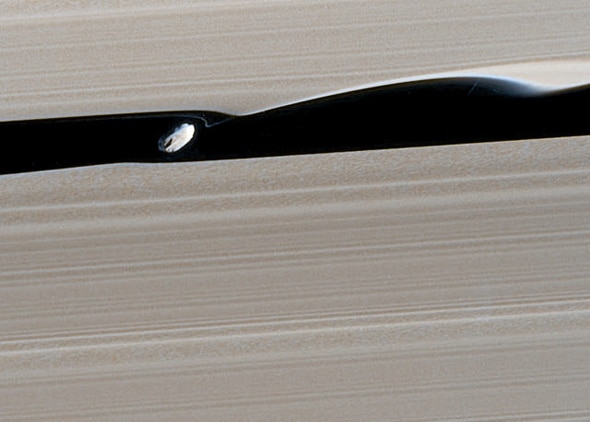Create a free profile to get unlimited access to exclusive videos, sweepstakes, and more!
If You Need Strength Today, Be Like Daphnis

Today is a difficult day. And it’s just the latest in what have been very, very difficult times.
I’ll be honest with you: Over the past few months, in between bouts of fury and incredulity, like so many of you, I have felt real despair. Watching the country I love, the people I care about, and the science to which I have devoted my life come under such attack has been extraordinarily difficult and painful.
It can be hard to find any comfort in situations like these. And I have no desire to utter to you any hollow phrases, any meaningless pablum that sounds deep but is of no actual content.
Instead, please indulge me for a moment.
First, read this article I wrote Thursday about Saturn’s moon Daphnis. It may seem like a non sequitur, but as you'll see it’s quite the opposite.
That image of Daphnis I posted Thursday is grayscale, a single picture of the moon taken by the Cassini Saturn probe. The one you see here was crafted by Ian Regan, using two images from Cassini to create a representation of the color. I actually saw his version first, the colors sublime, adding a subtle and delicate touch to the otherworldly vista.
It was in the evening when I first saw it, and I was in bed (perhaps ill-advisedly) checking Twitter before going to sleep. I was stunned … and I mean that literally, as in my brain locked up for a moment as the wonder of this image flowed into it.
For just a moment I wasn’t sure what I was seeing, and by that I mean which of Saturn’s panoply of moons and what part of the rings this depicted. Daphnis is so small that it’s only appeared as a barely resolved dot in previous images, and the detail in the surface features threw me. When I saw Regan’s caption identifying the moon, I was stunned anew, since I knew this was by far the highest-resolution photo of Daphnis we’ve ever seen, and likely ever will.
The more I gawked at this photo, the deeper my awe became. The ripples, the structures, the graininess of the rings, the smooth(ish) surface of Daphnis, the ringlets that are so narrow they challenge the ability of Cassini to resolve them, and most of all that gossamer thread of ring pulled away by the feeble gravity of this diminutive moon … all of this was a fantastic delight, a gift literally sent down from the heavens.
As I struggled to tease out the details of what I was seeing, a thought struck me: Daphnis was only discovered in the year 2005. Its presence was first suspected in 2004, when Cassini returned images of waves and spikes in a gap in Saturn’s rings, obviously sculpted by a tiny moon, though its exact location was at the time unknown. Observations were quickly planned to get better images of the gap where the ripples were seen, and in May 2005 astronomers announced they had found it. It was given the name Daphnis the very next year.
And here we are, a dozen years later, with a new and extraordinary view of this odd little satellite. As I lay in bed and mulled over that, a thought struck me. We’ve known about this moon for a decade or so, but how old is it? Millions of years? Billions? How long has this tiny chunk of ice been circling Saturn, carving these marvelous creations out of still tinier chunks of ice?
As I chewed on this, an honest-to-God chill went down my back. This moon has been silently gliding through Saturn’s rings since before humanity existed as a species, and likely far, far longer. It’s done this without notice, without discovery, without supervision, without any sense of purpose or any eyes seeing it.
Daphnis did what it does because it must. It follows the rules of science, dancing to the tune of gravity, and it wasn’t until just a few years ago that we too could read those notes, hear that music, and appreciate its melody.
Daphnis is so small you could circumnavigate it by foot in a few hours, provided you could maintain your traction in its faint whisper of gravity. Yet, in the vastness of Saturn’s rings, almost completely lost among a trillion, trillion particles, it still manages to make waves, to reach out and create an effect, to stir echoes in a system far larger than itself.
And when we ponder the reverberation of those echoes, they engender in us a sense of beauty. Of awe.
All of these thoughts were still ringing in my mind when I happened to see how my friend, astrophysicist Katie Mack, was herself inspired by this image from over a billion kilometers away, and how she captioned it.
Yes, these are trying times, and it is easy to feel overcome, to be overwhelmed by events. And yes, the Universe itself is telling you that you are small. But do you know what else it’s telling you?
You are mighty.
Go out and make a difference. It may be a small one, but its reach may be profound, and extend far beyond what you intend or might perceive.
Go. Be like Daphnis.


























